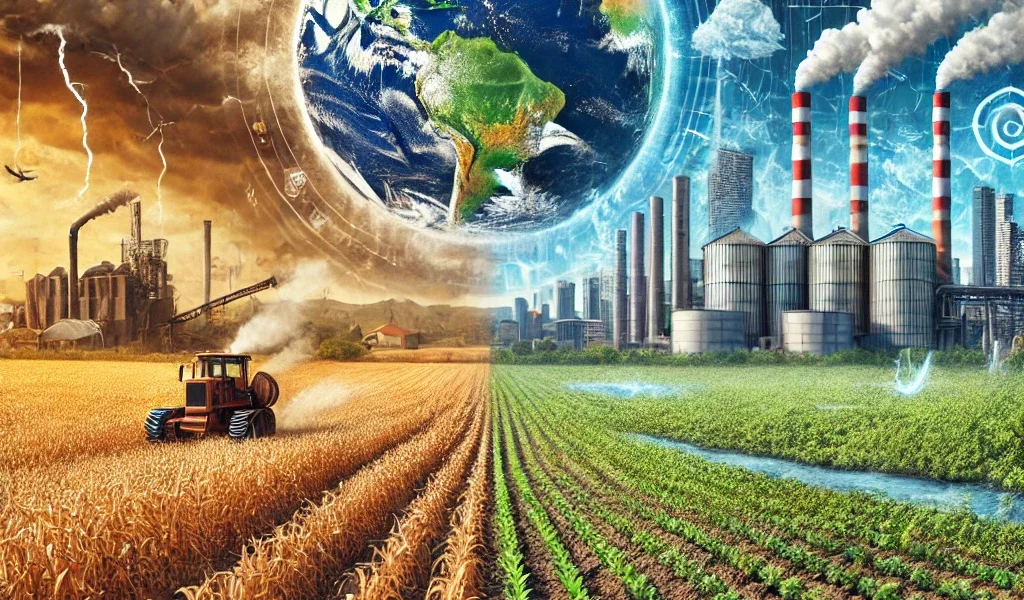Introduction
Climate change is no longer a distant threat—it is a present reality affecting economies worldwide. One of the most impacted sectors is agriculture, which relies on stable weather patterns, and industries that depend on raw materials and supply chain stability. Rising global temperatures, unpredictable weather events, and environmental disruptions are causing economic losses, shifting trade patterns, and demanding urgent adaptation measures. In this blog, we will explore the economic consequences of climate change on agriculture and industry, along with the opportunities and challenges it presents.
The Impact of Climate Change on Agriculture
1. Declining Crop Yields and Food Security Threats
Rising temperatures, droughts, floods, and changing precipitation patterns negatively affect agricultural productivity. Key consequences include:
- Reduced crop yields due to extreme heat and water scarcity.
- Increased prevalence of pests and diseases harming crops.
- Higher food prices due to supply shortages, impacting global food security.
2. Soil Degradation and Loss of Arable Land
Extreme weather conditions accelerate soil erosion, desertification, and loss of fertile land, leading to:
- Decreased agricultural productivity in many regions.
- Increased costs for farmers to implement soil restoration and irrigation measures.
- Shifts in farming regions, forcing relocation of agriculture-based communities.
3. Livestock and Fisheries at Risk
Climate change also affects animal husbandry and fisheries, leading to:
- Heat stress in livestock, reducing reproduction rates and milk production.
- Declining fish populations due to ocean acidification and rising sea temperatures.
- Economic instability in regions dependent on fishing and livestock industries.
4. Increased Costs for Farmers and Agribusinesses
Adapting to climate change requires significant investment, leading to:
- Higher costs for irrigation systems, crop insurance, and climate-resistant seeds.
- Increased dependency on technology-driven solutions like vertical farming and hydroponics.
- Government subsidies and financial assistance programs becoming crucial for farmer survival.
The Impact of Climate Change on Industry
1. Disruptions in Supply Chains and Production
Industries dependent on raw materials, transportation, and global trade are vulnerable to climate disruptions:
- Extreme weather events damage infrastructure, delaying production and logistics.
- Unpredictable weather patterns lead to shortages in essential raw materials like timber, water, and metals.
- Higher transportation costs due to fluctuating fuel prices and stricter environmental regulations.
2. Increased Operational Costs and Insurance Expenses
Companies are facing rising costs due to climate-related risks:
- Higher insurance premiums to cover damages caused by natural disasters.
- Investment in disaster-proof infrastructure and energy-efficient solutions.
- Regulatory compliance costs as governments impose stricter environmental policies.
3. Shifts in Consumer Preferences and Market Trends
As climate awareness grows, industries are adapting to shifting consumer demands:
- Increased demand for sustainable and eco-friendly products.
- Businesses investing in green energy solutions to reduce carbon footprints.
- Rising popularity of ethical sourcing and corporate social responsibility initiatives.
4. Economic Losses and Workforce Disruptions
Extreme weather events and environmental challenges lead to significant economic losses:
- Factory shutdowns due to hurricanes, floods, and wildfires.
- Job losses in climate-vulnerable industries such as fossil fuels and mining.
- Migration of workers as climate-related disasters force communities to relocate.
Opportunities for Economic Adaptation and Growth
1. Investment in Renewable Energy and Green Technologies
To mitigate economic losses, industries are shifting toward sustainability:
- Expansion of solar, wind, and hydroelectric power to reduce reliance on fossil fuels.
- Growth of green technologies, including electric vehicles and carbon capture solutions.
- Job creation in renewable energy sectors, fostering economic resilience.
2. Climate-Resilient Agriculture and Sustainable Practices
Farmers and agribusinesses are adopting innovative approaches:
- Development of drought-resistant crops and advanced irrigation methods.
- Implementation of precision agriculture using AI and IoT to optimize resource use.
- Promotion of sustainable farming techniques like organic agriculture and agroforestry.
3. Policy Interventions and Global Collaboration
Governments and international organizations are implementing measures to address climate change:
- Carbon pricing mechanisms to encourage businesses to lower emissions.
- Financial aid programs for industries transitioning to sustainable practices.
- Global trade agreements promoting environmentally responsible supply chains.
Conclusion
Climate change poses undeniable economic challenges to agriculture and industry, threatening food security, increasing costs, and disrupting markets. However, it also presents opportunities for innovation, green investments, and global cooperation. By adopting sustainable practices, leveraging technology, and enforcing climate-conscious policies, businesses and economies can mitigate risks and create a resilient, sustainable future.
As climate change continues to reshape economic landscapes, proactive adaptation will determine the prosperity of nations, businesses, and individuals in the years to come.




